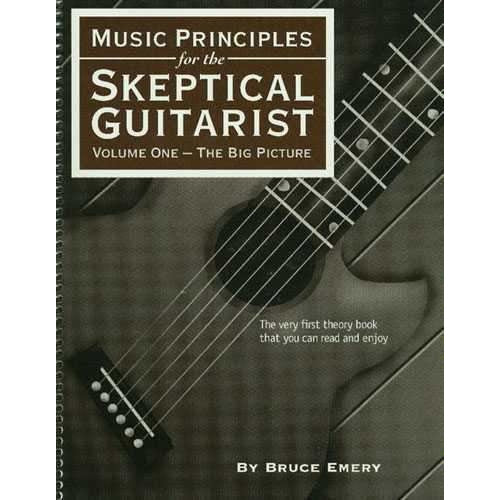-
 You qualify as a skeptical guitarist if "1. You doubt that learning about music theory can have any impact whatsoever on your guitar playing. You may even think it may cause you deep suffering. OR 2. You realize the value of music theory, but you've never found a book that proved to be particularly useful or easy to read. You don't expect this one to be any different." Try one more - this one! Emery starts with the big picture and carefully connects the dots in his volumes teaching music theory. He's funny, logical and avoids lapsing into unintelligible jargon. He really WANTS you to learn. Recommended! Spiralbound, 136 pp>
You qualify as a skeptical guitarist if "1. You doubt that learning about music theory can have any impact whatsoever on your guitar playing. You may even think it may cause you deep suffering. OR 2. You realize the value of music theory, but you've never found a book that proved to be particularly useful or easy to read. You don't expect this one to be any different." Try one more - this one! Emery starts with the big picture and carefully connects the dots in his volumes teaching music theory. He's funny, logical and avoids lapsing into unintelligible jargon. He really WANTS you to learn. Recommended! Spiralbound, 136 pp>
The exact appearance of this item may vary.
More Details
1
/
of
1
More Details
More Details
Contents:
The First Approach
Notes and pitches
The layout of the notes
Tuning the guitar
Chords and chord quality
The Big Fifteen chords
Playing in different keys
The 1-4-5 system
C-A-G-E-D examples
Chord Families
The 1 and 5 chords
Songs in different keys
The 1, 4 and 5 chords Songs in different keys
"Silent Night" in all 5 keys
Choosing the right key
Using the capo
Quiz time for the 1-4-5's Finding the starting note
Adding the Minor chords
Songs in the Keys of G and C
"Rhythm Changes" Secondary Dominants Bunches of useful chords (A-G)
The Second Approach
The Chromatic scale
Layout on the neck
The Major scale
The Key of C
Scale degrees and other keys
The Key of G
Worksheet for Major scales
Traveling by Fifths
Major scale summary
The flat keys
The fretboard and the keyboard
Major scale exercises
Back to Chord Families
The C Harmonized Diatonic scale
Major chords versus Minor chords
Four combinations of Thirds Other
Chord Families
Worksheets for Chord Families
C-A-G-E-D Chord Family summary Example: "Morning Has Broken"
Full Chord Family summary
Transposition chart
Details of the 1-4-5 relationship
The Dominant 7th chord
Overlapping Chord Families
Chord substitutions
Triad spellings
My Bio
The Circle of Fifths
More on Secondary Dominants
Examples in the Key of C
Down by a 5th = up by a 4th
Backcycling through all the keys
C-A-G-E-D Chord Family examples
Mixing in the Minor chords
The Jazz Turnaround
"Morning Has Broken" again
Yuletide Backcycling in a the C-A-G-E-D keys Starting notes
Shortcuts in terminology
The 4th of the 4th
Major 7th and Minor 7th chords
Minor keys
C Major versus A Minor
Three kinds of Minor scales
Carols in the Keys of Am, Dm, and Em
Appendix 1: Why the number "five"?
Appendix 2: Key signatures
Volume One in a nutshell
One last quiz
The First Approach
Notes and pitches
The layout of the notes
Tuning the guitar
Chords and chord quality
The Big Fifteen chords
Playing in different keys
The 1-4-5 system
C-A-G-E-D examples
Chord Families
The 1 and 5 chords
Songs in different keys
The 1, 4 and 5 chords Songs in different keys
"Silent Night" in all 5 keys
Choosing the right key
Using the capo
Quiz time for the 1-4-5's Finding the starting note
Adding the Minor chords
Songs in the Keys of G and C
"Rhythm Changes" Secondary Dominants Bunches of useful chords (A-G)
The Second Approach
The Chromatic scale
Layout on the neck
The Major scale
The Key of C
Scale degrees and other keys
The Key of G
Worksheet for Major scales
Traveling by Fifths
Major scale summary
The flat keys
The fretboard and the keyboard
Major scale exercises
Back to Chord Families
The C Harmonized Diatonic scale
Major chords versus Minor chords
Four combinations of Thirds Other
Chord Families
Worksheets for Chord Families
C-A-G-E-D Chord Family summary Example: "Morning Has Broken"
Full Chord Family summary
Transposition chart
Details of the 1-4-5 relationship
The Dominant 7th chord
Overlapping Chord Families
Chord substitutions
Triad spellings
My Bio
The Circle of Fifths
More on Secondary Dominants
Examples in the Key of C
Down by a 5th = up by a 4th
Backcycling through all the keys
C-A-G-E-D Chord Family examples
Mixing in the Minor chords
The Jazz Turnaround
"Morning Has Broken" again
Yuletide Backcycling in a the C-A-G-E-D keys Starting notes
Shortcuts in terminology
The 4th of the 4th
Major 7th and Minor 7th chords
Minor keys
C Major versus A Minor
Three kinds of Minor scales
Carols in the Keys of Am, Dm, and Em
Appendix 1: Why the number "five"?
Appendix 2: Key signatures
Volume One in a nutshell
One last quiz
MUSIC PRINCIPLES FOR THE SKEPTICAL GUITARIST: VOLUME ONE
MUSIC PRINCIPLES FOR THE SKEPTICAL GUITARIST: VOLUME ONE
New
SKU: 578-2
Regular price
$24.95 USD
Regular price
Sale price
$24.95 USD
Unit price
/
per
Shipping calculated at checkout.
Experience the Elderly Difference
You qualify as a skeptical guitarist if "1. You doubt that learning about music theory can have any impact whatsoever on your guitar playing. You may even think it may cause you deep suffering. OR 2. You realize the value of music theory, but you've never found a book that proved to be particularly useful or easy to read. You don't expect this one to be any different." Try one more - this one! Emery starts with the big picture and carefully connects the dots in his volumes teaching music theory. He's funny, logical and avoids lapsing into unintelligible jargon. He really WANTS you to learn. Recommended! Spiralbound, 136 pp>
More DetailsCouldn't load pickup availability
More Details
More Details
Contents:
The First Approach
Notes and pitches
The layout of the notes
Tuning the guitar
Chords and chord quality
The Big Fifteen chords
Playing in different keys
The 1-4-5 system
C-A-G-E-D examples
Chord Families
The 1 and 5 chords
Songs in different keys
The 1, 4 and 5 chords Songs in different keys
"Silent Night" in all 5 keys
Choosing the right key
Using the capo
Quiz time for the 1-4-5's Finding the starting note
Adding the Minor chords
Songs in the Keys of G and C
"Rhythm Changes" Secondary Dominants Bunches of useful chords (A-G)
The Second Approach
The Chromatic scale
Layout on the neck
The Major scale
The Key of C
Scale degrees and other keys
The Key of G
Worksheet for Major scales
Traveling by Fifths
Major scale summary
The flat keys
The fretboard and the keyboard
Major scale exercises
Back to Chord Families
The C Harmonized Diatonic scale
Major chords versus Minor chords
Four combinations of Thirds Other
Chord Families
Worksheets for Chord Families
C-A-G-E-D Chord Family summary Example: "Morning Has Broken"
Full Chord Family summary
Transposition chart
Details of the 1-4-5 relationship
The Dominant 7th chord
Overlapping Chord Families
Chord substitutions
Triad spellings
My Bio
The Circle of Fifths
More on Secondary Dominants
Examples in the Key of C
Down by a 5th = up by a 4th
Backcycling through all the keys
C-A-G-E-D Chord Family examples
Mixing in the Minor chords
The Jazz Turnaround
"Morning Has Broken" again
Yuletide Backcycling in a the C-A-G-E-D keys Starting notes
Shortcuts in terminology
The 4th of the 4th
Major 7th and Minor 7th chords
Minor keys
C Major versus A Minor
Three kinds of Minor scales
Carols in the Keys of Am, Dm, and Em
Appendix 1: Why the number "five"?
Appendix 2: Key signatures
Volume One in a nutshell
One last quiz
The First Approach
Notes and pitches
The layout of the notes
Tuning the guitar
Chords and chord quality
The Big Fifteen chords
Playing in different keys
The 1-4-5 system
C-A-G-E-D examples
Chord Families
The 1 and 5 chords
Songs in different keys
The 1, 4 and 5 chords Songs in different keys
"Silent Night" in all 5 keys
Choosing the right key
Using the capo
Quiz time for the 1-4-5's Finding the starting note
Adding the Minor chords
Songs in the Keys of G and C
"Rhythm Changes" Secondary Dominants Bunches of useful chords (A-G)
The Second Approach
The Chromatic scale
Layout on the neck
The Major scale
The Key of C
Scale degrees and other keys
The Key of G
Worksheet for Major scales
Traveling by Fifths
Major scale summary
The flat keys
The fretboard and the keyboard
Major scale exercises
Back to Chord Families
The C Harmonized Diatonic scale
Major chords versus Minor chords
Four combinations of Thirds Other
Chord Families
Worksheets for Chord Families
C-A-G-E-D Chord Family summary Example: "Morning Has Broken"
Full Chord Family summary
Transposition chart
Details of the 1-4-5 relationship
The Dominant 7th chord
Overlapping Chord Families
Chord substitutions
Triad spellings
My Bio
The Circle of Fifths
More on Secondary Dominants
Examples in the Key of C
Down by a 5th = up by a 4th
Backcycling through all the keys
C-A-G-E-D Chord Family examples
Mixing in the Minor chords
The Jazz Turnaround
"Morning Has Broken" again
Yuletide Backcycling in a the C-A-G-E-D keys Starting notes
Shortcuts in terminology
The 4th of the 4th
Major 7th and Minor 7th chords
Minor keys
C Major versus A Minor
Three kinds of Minor scales
Carols in the Keys of Am, Dm, and Em
Appendix 1: Why the number "five"?
Appendix 2: Key signatures
Volume One in a nutshell
One last quiz



